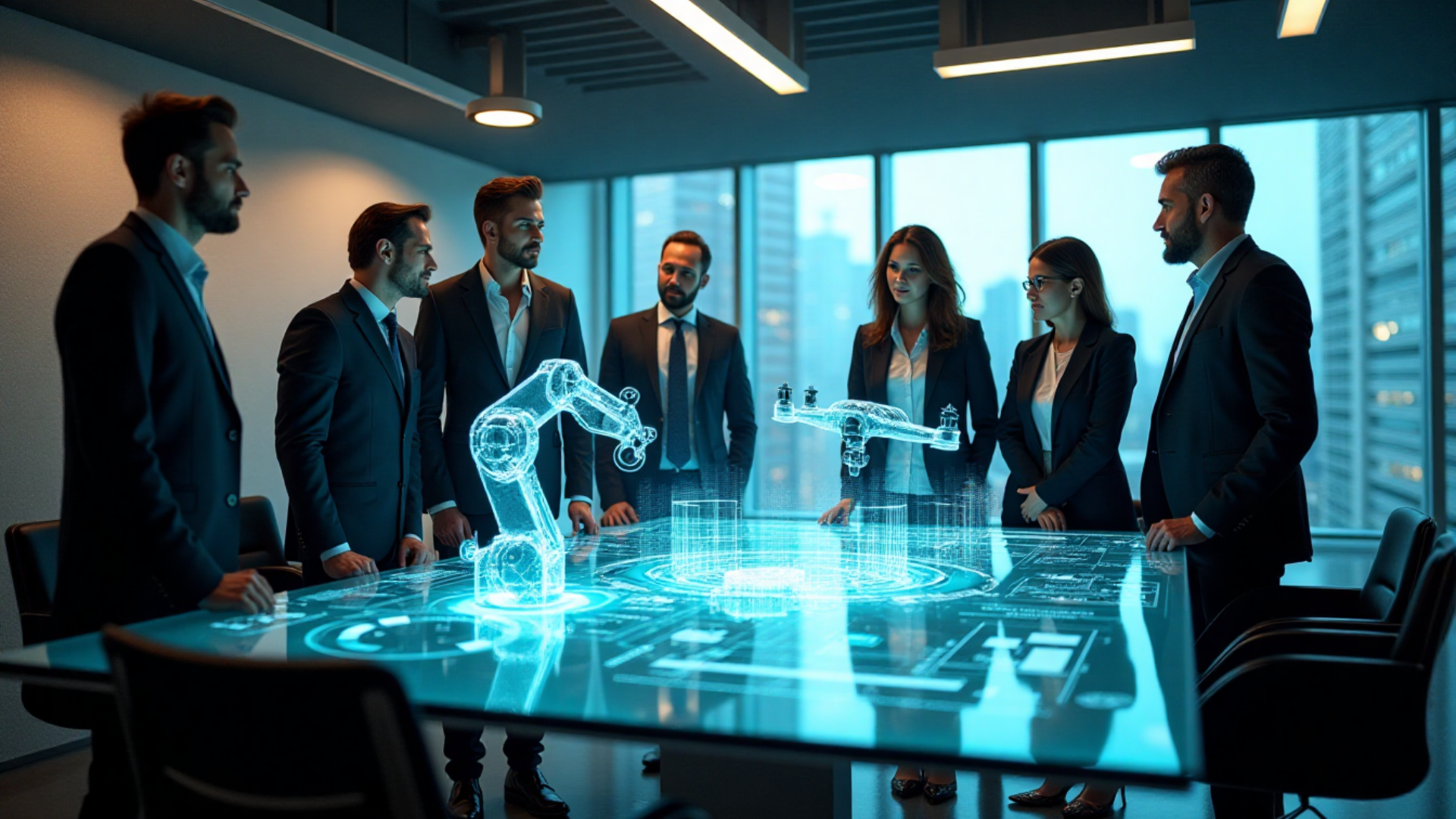What Are Computer Vision Services? Definition and Use Cases
by Nohad Ahsan, Last updated: November 19, 2025, Code:

Discover how computer vision services transform industries by automating security, quality control, logistics, and more. This blog explores real-world applications of AI-powered solutions that enhance efficiency, accuracy, and decision-making across various sectors.
Computer vision services have quickly become a transformative force in industries ranging from healthcare to manufacturing. But despite their growing importance, many businesses still struggle to leverage this powerful technology effectively.
A report from Statista revealed that the global computer vision market is projected to reach US$29.27 billion by the end of 2025, reflecting the growing reliance on AI-driven visual data analysis. Yet, many organizations still face significant barriers when it comes to integrating computer vision into their operations.
This is where computer vision services come in, offering businesses the ability to automate, analyze, and extract insights from images and videos at scale. These services enhance decision-making and operational efficiency, eliminating manual work and reducing errors.
In 2025, AI-powered visual intelligence isn't a "nice-to-have"—it's the competitive advantage separating market leaders from laggards. Whether you're running a hospital, a factory, a logistics hub, or a government agency, computer vision is automating what was once impossible, delivering accuracy at an unprecedented scale.
In this blog, we’ll explore computer vision services, how they work, and the key use cases driving innovation across industries. Whether you’re a healthcare provider looking to speed up diagnostics or a retailer aiming to optimize operations, understanding the value of computer vision is the first step toward future-proofing your business.
What Are Computer Vision Services?
Computer vision services, also called Vision AI, is a rapidly evolving field that leverages artificial intelligence (AI) to process and interpret visual data, such as images and videos.

This technology allows machines to recognize and understand visual information, mimicking human sight and cognitive functions.
AI Vision utilizes deep learning models and machine learning algorithms to analyze, detect, and recognize objects, patterns, and even specific actions within images or video streams.
Vision AI is fundamentally transforming industries by automating processes that were once handled manually.
Whether it's identifying specific objects in an image, detecting anomalies, or providing actionable insights, AI Vision is powering a new wave of automation and efficiency across sectors.
How Does Computer Vision Work?
At the core of Vision AI is its ability to replicate the human visual system, but with much greater speed and accuracy.
AI Vision enables machines to process complex visual data and help make decisions, which is critical in healthcare, automotive, and retail industries.
This technology uses deep learning algorithms and machine learning models to analyze pixels, detect patterns, and even recognize and understand visual content at scale.
By leveraging Vision AI, systems can evolve and become increasingly accurate as they process more data and receive feedback.
- Image Recognition: This is the process where the system identifies objects, people, or places in an image.
- Pattern Recognition: Computer vision detects recurring patterns within images, which aids in identifying objects or actions.
The Role of AI in Computer Vision
Artificial intelligence (AI) is what drives computer vision, allowing machines to make decisions based on visual data. Over time, AI systems continuously learn and improve, becoming more accurate in their recognition abilities.
This is accomplished through two major subsets of AI—machine learning (ML) and deep learning.
- Machine Learning: Allows systems to "learn" from large datasets of visual information, improving their accuracy over time.
- Deep Learning: A more advanced AI method where neural networks replicate the way the human brain processes visual data, enabling highly complex tasks like facial recognition and object detection.
Key Technologies in Computer Vision
Several cutting-edge technologies drive the capabilities of computer vision systems, allowing them to "see" and interpret visual data effectively. These technologies include:
- Image Recognition: This fundamental task of computer vision involves identifying specific objects, people, or places within images. The system classifies visual data based on learned features like shape, texture, and size. For instance, it can be trained to recognize a dog by analyzing its key features.
- Object Detection: Object detection takes it further by identifying objects and determining their precise location within an image. It involves drawing bounding boxes around objects like cars, pedestrians, or traffic signs. This is essential for applications like autonomous driving, where accurate identification and positioning are vital for safety.
- Video Analytics: Extending computer vision to dynamic video streams, video analytics analyzes footage to detect motion, track objects, and identify anomalies. This is widely used in surveillance systems to monitor activities and track movements, improving security. Retailers also use video analytics to optimize store layouts based on customer movement patterns.
- Facial Recognition: A specialized form of computer vision, facial recognition identifies or verifies individuals based on their unique facial features. By analyzing landmarks like the distance between eyes, nose, and mouth, the system can match faces against a database of known individuals. This technology is increasingly used for security, customer identity verification, and access control systems.
- Optical Character Recognition (OCR): OCR technology allows computer vision systems to extract and convert text from scanned images or photos into editable text. It is widely used for document digitization, license plate recognition, and sign recognition, enabling businesses to automate data extraction and processing from visual sources.
VIDIZMO computer vision solutions integrate these key technologies, allowing businesses to streamline operations, improve decision-making, and unlock valuable insights from visual data.
Applications of Computer Vision Services
Computer vision services are increasingly being applied in various industries, from healthcare to manufacturing, and retail.

By automating tasks that would otherwise require human intervention, these systems enable faster, more efficient processes, reduced errors, and better decision-making capabilities.
In summary, computer vision services empower machines to interpret visual data like humans, and with continuous improvements from AI, they are driving significant advancements in numerous sectors.
From object detection to facial recognition, computer vision's capabilities are evolving rapidly, offering immense potential for automation and data-driven decision-making.
Understanding AI and Machine Learning in Vision AI
At the core of Vision AI lies artificial intelligence (AI), which enables machines to perform tasks traditionally requiring human intelligence. In the context of computer vision, AI algorithms process visual data—such as images and videos—to recognize patterns, identify objects, and understand the context within the data.
AI’s Role: AI enables machines to interpret visual data, allowing systems to make decisions based on what they "see."
Learning from Data: These systems improve over time as they are exposed to more data and receive continuous feedback, enabling them to increase accuracy and efficiency.
Machine Learning (ML) in Computer Vision
Machine learning (ML), a subset of AI, plays a pivotal role in the development and enhancement of vision AI technology. ML algorithms allow systems to "learn" from examples, improving their performance as they process more data.
Supervised Learning: This involves training a model with labeled images (for example, a picture of a dog labeled as “dog”), allowing the model to learn features and patterns that distinguish different objects.
Unsupervised Learning: In contrast, unsupervised learning allows models to find patterns in data without labeled images, helping to identify trends or groupings within the data.
Deep Learning: The Power Behind Advanced Recognition
Deep learning, an advanced subset of machine learning, leverages neural networks to mimic the structure of the human brain.
This enables machines to perform more complex image recognition tasks, such as identifying faces, interpreting emotions, and even predicting actions based on visual cues.

Convolutional Neural Networks (CNNs): CNNs are a specific type of deep learning model that excels at recognizing visual patterns in images and videos.
These networks have specialized layers that detect features such as edges, textures, and shapes, essential for identifying objects or people in images.
In summary, AI and machine learning work hand-in-hand in computer vision systems to enable them to learn, recognize patterns, and improve over time.
With the help of deep learning models like CNNs, these systems can tackle more complex visual recognition tasks, from facial recognition to predicting actions based on visual data.
Why Computer Vision is Transforming Industries
Computer vision services drive profound changes across various industries by automating tasks, improving operational efficiency, and providing valuable insights. By mimicking human vision, vision AI allows machines to analyze and understand visual information.
This technology has become a game-changer in many sectors, enabling businesses to automate previously complex tasks and enhance decision-making.
Here are several ways Computer Vision Services Are Revolutionizing Industries:
Enhancing Security & Surveillance with AI-Powered Monitoring
AI-powered surveillance systems help detect suspicious activities, unauthorized entry, and unattended objects. By automating anomaly detection, these systems enable faster responses and enhanced security while reducing reliance on human monitoring.

Government agencies use AI to monitor critical infrastructure, detect trespassers, and prevent security breaches. AI-driven facial recognition helps law enforcement identify persons of interest.
Automating Quality Control in Manufacturing
AI-powered computer vision systems can inspect products for defects, ensuring only flawless items reach customers. This reduces waste, eliminates human error, and enhances production efficiency.
Car manufacturers use AI to detect flaws in parts, preventing defective components from entering production. These systems automatically adjust production parameters based on defect trends, improving overall efficiency.
Automating Sensitive Data Redaction for Compliance
Vision AI solutions automatically redact sensitive information such as faces and text from videos and images. This ensures compliance with data protection regulations, reducing legal risks and improving efficiency.

Government agencies, healthcare institutions, and enterprises handle vast amounts of PII, PHI, and confidential records. Failure to secure this data can lead to legal penalties under CCPA, HIPAA, FOIA, and GDPR. Manual redaction is slow and error-prone, making AI-powered computer vision services essential for automating data protection.
Beyond compliance, custom computer vision development services help enterprises secure financial data, contracts, and trade secrets. AI-powered redaction ensures privacy, reduces legal risks, and streamlines regulatory compliance. Organizations can protect sensitive information by integrating computer vision services while improving efficiency.
Law enforcement uses AI to blur faces in bodycam footage, while healthcare providers use AI to protect patient health information (PHI) in medical records.
Traffic Management & Smart Cities
AI-based computer vision optimizes traffic flow, reduces congestion, and enforces road safety laws.

These systems can automatically detect traffic violations, monitor vehicle types, and adjust toll systems based on traffic data.
Smart cities use AI to improve emergency response times, detect reckless driving, and ensure safer pedestrian crossings by analyzing traffic data.
Workplace Safety & PPE Compliance
AI-powered computer vision systems monitor workers' compliance with safety protocols, ensuring that all necessary protective gear is worn.
This automation reduces workplace accidents and helps organizations meet safety regulations.

Workplace safety violations can lead to costly lawsuits, severe injuries, and reputational damage. OSHA fines for non-compliance can reach hundreds of thousands per incident.
Construction sites use AI to monitor workers' PPE adherence, reducing the likelihood of workplace injuries and improving safety standards.
Optimizing Logistics with AI-Powered Shipment & Warehouse Tracking
AI-based computer vision systems track inventory, detect damage, and ensure efficient routing of shipments.
These systems enhance the accuracy of logistics operations, reducing delays and improving customer satisfaction.
A warehouse uses AI-powered computer vision to detect damaged goods on a conveyor belt. This ensures only intact products are shipped, reducing returns and customer complaints.
Preventing Poaching & Wildlife Crime with AI Surveillance
AI-based computer vision detects unauthorized movement in protected areas, preventing illegal activities like poaching and deforestation.

AI cameras in wildlife reserves alert rangers to illegal hunting activities.
AI-powered tracking systems monitor animal migration patterns, helping conservationists protect endangered species more effectively.
Smart Inventory & Customer Insights in Retail
According to a 2024 study by Statista, nearly 40% of retail directors in the U.S. and EMEA reported using AI, computer vision (CV), and machine vision (MV) for specific operations. Additionally, 35% have already scaled these technologies, while 15% plan to implement them within the next year.
AI-powered computer vision helps retailers monitor inventory levels, optimize store layouts, and analyze customer behavior. This improves sales strategies and enhances customer satisfaction.
Large retailers use AI-driven cameras to track customer movement and buying patterns, adjusting store displays and promotions for increased sales. Additionally, automated checkout systems powered by computer vision reduce wait times and improve customer satisfaction.

Want to dive deeper? Explore our blog on 10 Ways How Computer Vision Services Are Shaping Modern Enterprises to learn how this technology is transforming industries across the globe.
Key Challenges and How to Overcome Them
Implementing computer vision solutions can present several challenges. From data quality to system integration, businesses may face obstacles that hinder the adoption of this technology.
Let's explore some of the most common challenges faced while implementing computer vision and how businesses can overcome them.
Data Quality and Availability
Computer vision systems rely heavily on large datasets to train AI models. The accuracy of these models depends directly on the quality and diversity of the data used.
Challenges:
- Noisy data: Low-resolution images, poor lighting, and excessive noise can hinder recognition.
- Lack of labeled data: Manual labeling is time-consuming and costly.
- Insufficient data diversity: Limited examples can cause poor performance in new situations.
How to Overcome It:
- Data Augmentation: Use techniques like rotation, scaling, and noise addition to expand datasets.
- Crowdsourcing Data Labeling: Use crowdsourcing platforms to label data more efficiently.
- Partnerships with Data Providers: Collaborate with organizations to access high-quality labeled datasets.
Integrating computer vision into existing systems can be a complex task, especially when working with legacy infrastructure.
Challenges:
- Legacy Systems Compatibility: Older IT systems may not be equipped for high-demand processing.
- Data Silos: Disparate data storage systems can make gathering visual data difficult.
- Complexity in Integrating with Other AI Tools: Combining computer vision with other AI technologies requires expertise.
How to Overcome It:
- Cloud-Based Solutions: Leverage cloud platforms for scalable integration.
- API Integration: Use APIs to integrate computer vision into existing workflows seamlessly.
- Consulting and Customization: Work with specialized vendors to tailor the solution for your infrastructure.
Model Training and Fine-Tuning
Training a computer vision model is resource-intensive and requires substantial computational power.
Challenges:
- Training Time and Resource Intensity: Training deep learning models can be expensive and time-consuming.
- Model Overfitting or Underfitting: Too much training data leads to overfitting, while too little data causes underfitting.
- Continuous Adaptation: Models need regular updates to adapt to changing conditions.
How to Overcome It:
- Leverage Pre-trained Models: Use pre-trained models to save time and resources.
- Transfer Learning: Adapt existing models to new tasks with fewer data.
- Ongoing Monitoring and Fine-Tuning: Continuously monitor model performance and update when necessary.
Data Privacy and Security Concerns
Data privacy and security are significant concerns when implementing computer vision systems, particularly when dealing with sensitive or personally identifiable information (PII), such as in security systems, healthcare, and retail.
Challenges:
- Data Breaches: Unauthorized access to visual data can lead to security risks.
- Regulatory Compliance: Organizations must comply with privacy regulations like GDPR and CCPA.
How to Overcome It:
- Encryption and Access Control: Use strong encryption and implement role-based access controls.
- Anonymization and Masking: Mask sensitive data such as faces to protect privacy.
- Compliance with Regulations: Ensure your systems meet data privacy laws through robust security protocols.
By leveraging advanced tools like pre-trained models, edge computing, and optimized algorithms, and ensuring compliance with privacy regulations, businesses can effectively overcome these challenges and unlock the full potential of computer vision technology.
Organizations can reap the rewards of automation, efficiency, and valuable data insights with the right approach.
Experience Cutting-Edge AI with VIDIZMO’s Computer Vision Services
As industries evolve, the need for intelligent automation and AI-driven insights has never been greater. VIDIZMO’s Computer Vision Development Services offer tailored solutions to help businesses streamline operations, enhance security, and gain visual intelligence.
Whether it’s optical character recognition (OCR) for automated data extraction, AI-powered object detection for surveillance, or PPE compliance monitoring for workplace safety, VIDIZMO enables enterprises and government agencies to harness the full potential of computer vision services.
With our custom computer vision development services, organizations can build AI models that cater to industry-specific challenges, from automated facial attribute recognition for security to brand detection in digital media.
Powered by advanced machine learning and deep learning algorithms, VIDIZMO’s AI-driven solutions ensure high accuracy, scalability, and seamless integration with existing enterprise workflows.
Unlocking the Future with Computer Vision Services
The rapid advancements in computer vision services are transforming industries by automating critical processes, improving efficiency, and ensuring accuracy at scale. From logistics optimization and financial fraud prevention to wildlife conservation and data security, organizations are leveraging AI-powered solutions to stay ahead in an increasingly digital world.
As enterprises and government agencies continue to embrace custom computer vision development services, the potential for innovation and operational excellence grows exponentially. Now is the time to explore AI-driven automation and see how it can enhance security, productivity, and compliance within your organization.
Embrace the future with VIDIZMO’s AI-powered Computer Vision Development Services and transform how you analyze, monitor, and optimize visual data.
Ready to integrate AI-powered solutions into your business? Explore our computer vision development services today to learn how computer vision services can transform your business.
People Also Ask
What are Computer Vision Services?
Computer vision services refer to the technology that enables machines to interpret and understand visual data, such as images and videos, just like humans do. Using artificial intelligence (AI) and machine learning algorithms, computer vision systems can identify objects, detect patterns, recognize faces, and analyze content on a large scale.
What industries benefit most from computer vision services?
Computer vision services benefit a wide range of industries, including healthcare, retail, manufacturing, security, agriculture, and logistics. In healthcare, it helps with medical image analysis, while in retail, it optimizes inventory and customer experience. In manufacturing, computer vision improves quality control, and in security, it automates surveillance monitoring and threat detection. Each industry leverages computer vision to improve operational efficiency, reduce costs, and enhance safety.
How can computer vision improve security systems?
Computer vision enhances security systems by automating surveillance and anomaly detection. AI-powered cameras continuously monitor video feeds, instantly detecting suspicious activities, unauthorized access, or security threats. This reduces the reliance on manual monitoring, enabling faster response times and more effective security management, while also ensuring compliance with industry regulations.
What are the challenges of implementing computer vision in business?
The main challenges in implementing computer vision include data quality issues, system integration, and the complexity of training accurate AI models. Ensuring high-quality, labeled data for training is crucial, as is overcoming compatibility issues with legacy systems. Additionally, processing demands can cause latency issues. However, these challenges can be mitigated using pre-trained models, leveraging edge computing, and ensuring continuous fine-tuning.
How is computer vision used in healthcare?
In healthcare, computer vision is used for medical image analysis, assisting in the diagnosis of conditions such as cancer, fractures, and heart disease by analyzing X-rays, CT scans, and MRIs. AI-powered solutions can detect abnormalities with high accuracy, allowing for quicker diagnoses and improving patient outcomes. Additionally, computer vision is used in surgery, robotics, and even in monitoring patient vitals remotely.
Can computer vision be integrated into existing business systems?
Yes, computer vision can be integrated into existing business systems. Using cloud-based platforms and APIs, businesses can incorporate computer vision capabilities into their current infrastructure without significant hardware upgrades. Custom solutions can be developed to ensure seamless integration, allowing businesses to automate processes like inventory management, surveillance, and customer analytics while minimizing disruption to existing operations.
What are some real-world examples of computer vision in logistics?
In logistics, computer vision is used for tracking shipments, warehouse automation, and inventory management. AI-powered systems can detect damaged goods on a conveyor belt, automate stock checks, and even analyze shipping routes to optimize delivery times. This technology helps streamline operations, reduce human error, and ensure faster, more accurate deliveries.
How does computer vision help in retail?
In retail, computer vision is used for inventory management, shelf monitoring, and customer behavior analysis. AI systems can automatically track stock levels, optimize product placement, and detect missing or misplaced items on shelves. By analyzing customer movements and interactions, retailers can also enhance store layouts and personalize the shopping experience, leading to increased sales and customer satisfaction.
What is semantic segmentation in computer vision?
Semantic segmentation is an advanced technique in computer vision that classifies each pixel in an image into categories or labels. This allows machines to understand the context of different parts of an image at a granular level, making it particularly useful for applications like autonomous driving, where precise understanding of road conditions, pedestrians, and vehicles is required to make decisions.
How can AI-powered computer vision enhance workplace safety?
AI-powered computer vision enhances workplace safety by automating the monitoring of personal protective equipment (PPE) compliance and detecting unsafe behaviors. For example, AI systems can detect workers not wearing helmets, gloves, or safety vests and immediately alert safety personnel. This helps businesses ensure compliance with safety regulations and reduces the risk of workplace accidents.
Jump to
You May Also Like
These Related Stories

10 Ways How Computer Vision Services Are Shaping Modern Enterprises

Why Enterprises Are Adopting Domain-Specific AI Agents



No Comments Yet
Let us know what you think